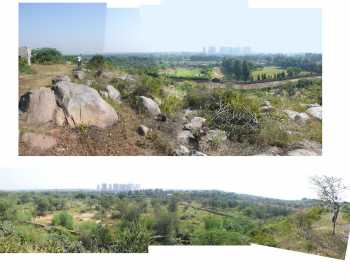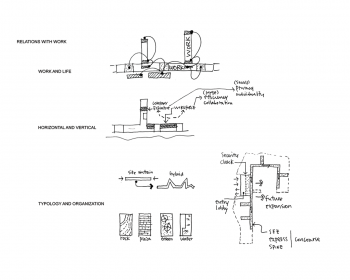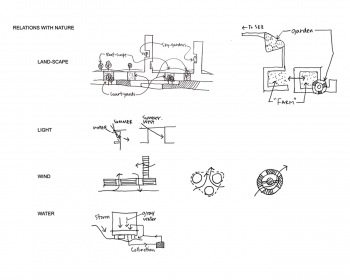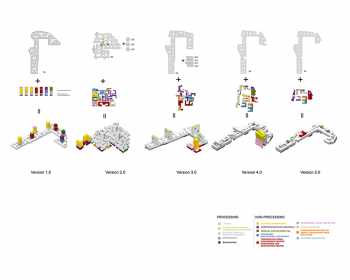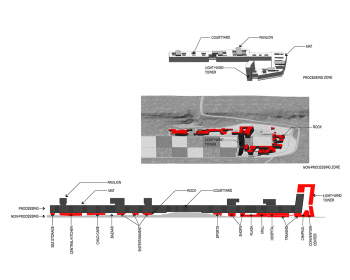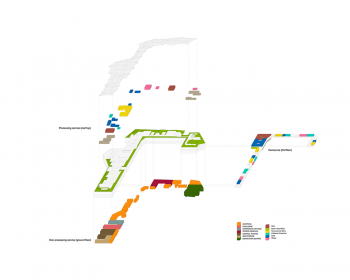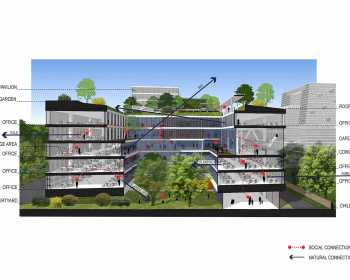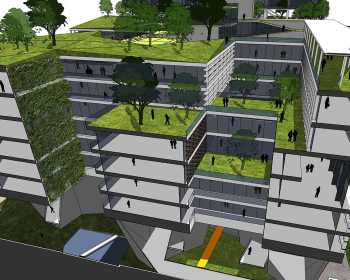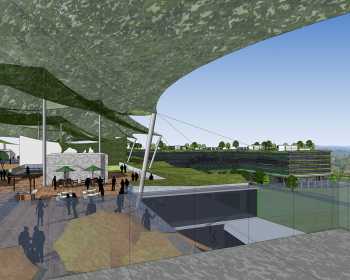Metro Valley
Eco-Knowledge City is one city and many cities at the same time. Eco-Knowledge City weaves these different cities into one synthetic whole. Its agenda set for the future, its root grounded in the culture, Eco-Knowledge City aspires to high ideals that are not predicated on superficial extravaganza.
The parallel city is made of two linear cities stacked up vertically, the City of Processing Area and the City of Non-processing Area. The former floats above and is accessible from the high point of the site. While the latter occupies the entire undulating ground and is accessible to everyone. With its vibrant and comprehensive programs, the lower city ‘supports’ the city above, functionally and structurally, while fulfilling the SEZ requirement of a clear separation.
Instead of challenging the limit of gravity skyward, the horizontal city is a floating mat structure punctured by courtyards as inspired by traditional Indian architecture. It caters to knowledge industry that often demands large contiguous floor plate. Its modular system accommodates companies of all sizes at ease. Each office unit has at least one internal courtyard that provides nature light, shading and ventilation. The courtyards are the micro CLIMATE REGULATORS as well as the SOCIAL ENERGIZERS. Office space arranged around the courtyard provides higher visibility for people of the same company but working in different teams, an important factor proven to enhance productivity. Terraces in the courtyards provide spaces for relaxation and social encounters. Every courtyard is composed of different elements from a design matrix to achieve different appearances. Yet they are threaded together by two consistent themes, the nature and the culture.
The horizontal city enjoys the closeness to the ground which reconnects people to the nature - the basis of human creativity. It also greatly reduces the dependency on elevators.
In the green city, green is the attitude, the necessity; green is grounded in the indigenous conditions. The floating porous mat structure is sandwiched in between double nature. While leaving much of the natural landscape beneath untouched, it carries an artificial nature integrated with active social programs on the rooftop. The porosity of the mat made possible the seamless integration of light, air, greenery and nature into the building system. Air moves freely through the courtyards that open to both the ground and the sky, carrying with it vapor from the ponds and regulating the micro climate around the building. With strategic placement of the circulation spine, people are encouraged to travel on stairs rather than elevators - there goes a significant percentage of energy cost. Carefully designed shading systems modulate the façade and courtyards to minimize unwanted solar heat gain while maximizing day lighting to work spaces. Utilization of renewable energy such as geothermal, solar and wind will reduce the reliance on traditional fossil-fuel based energy. Recycled, renewable, low energy embodied material will be used whenever possible. A wetland is created to process building waste water and store excess water from the monsoon season, while providing a unique landscape feature.
The infrastructure city manifests itself in its efficient distribution of people and services. Building functions as the facilitator rather than the dominator. It is analogous to a highly efficient airport, where large number of people is properly checked and directed to their respective terminals in a linear fashion. The concourse, acting as the express horizontal circulation, the social artery, the internal main street and the service links, is the central spine to the entire city. It makes efficient use of various building systems that are typically scattered and repeated in separate building blocks.
The timeless city assumes timeless appearance by not dressing up with fashion statements. At the core, it is the true Indian spirit. Taking inspiration from traditional Indian architecture for space making, the timeless city blurs the boundary between the inside and outside, between nature and manmade. It is modernity rooted in Indian culture.
